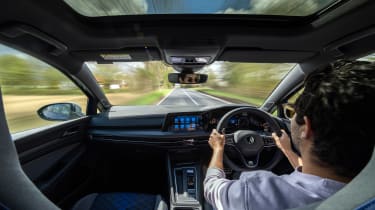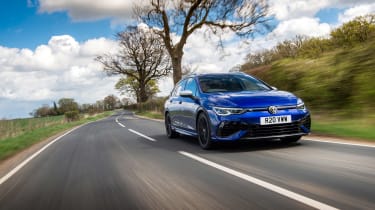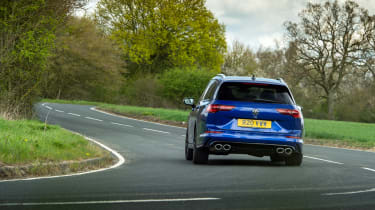Volkswagen Golf R Estate 2022 review – still the do-all high-performance family car?
The latest Golf R Estate drives much the same as the hatch, but with plenty of extra versatility thrown in
It’s fair to say we’ve had a somewhat frosty relationship with the current eighth-generation Golf R. Initially we were impressed, if not wowed, when we first drove it in both base and ‘R-Performance Package’ guises (evo 284 and 286), but when stiffer competition came along in last year’s hot hatchback throwdown against the Honda Civic Type R and Mercedes-AMG A45 S (evo 288), well, it was positively crushed, completely running out of ideas on admittedly very challenging roads and against the very sharpest of competition. Now, however, a great leveller has come to the Golf R’s aid, and it’s not a further Performance Package, or even a quiet engineering update from Germany, rather something altogether more powerful: context.
While a Golf R hatchback is no more practical than a Civic Type R, when fitted with a more versatile estate body it’s impossible to draw that comparison, making its rivals more likely to be high-performance compact SUVs than a precision hot hatchback. So how does the Golf R Estate translate as a high-performance family wagon, then? Very well, on initial impression. Find the nondescript square starter button and the Golf R instinctively starts in Sport mode, giving the powertrain a good amount of initial response and the steering some meaningful weight. This can, of course, be dialled right back, and when combined with the (still) optional adaptive dampers immediately gives the R Estate an impressive baseline to work from.
More reviews
Performance between the hatchback and wagon feels nigh on identical in the real world, although on paper the Estate’s 0-62mph time of 4.9sec is a 0.2sec disadvantage on account of its 76kg weight penalty. Both share the same 316bhp/310lb ft variant of the EA888 turbocharged four-cylinder engine, seven-speed dual-clutch transmission and torque-vectoring rear differential. It’s the last of these components that differentiates the Golf R Estate from the closely related Cupra Leon ST.
The hatchback’s R-Performance Package is also available for the Estate for an additional £2160, bundling a raised top speed of 167mph, those two extra drive mode options (Drift and Special), a rear spoiler and 19-inch wheels and tyres. Staggeringly, the adaptive dampers are still a further £840, and really are required, as despite being pointlessly difficult to access, their 15-stage configurability does give them impressive breadth.
Initially the Golf R Estate feels pretty much like any other Golf R, except this time the rear screen is a further 350mm further behind you. There’s good grip across the front axle, and with some weight dialled in to the rack it does give you a certain level of confidence as you enter a corner, even if the front wheels still don’t quite key into the surface as much as you’d want. Push a little harder, though, and the Golf R’s handling does feel slightly more demure than that of the hatch, losing a little of the vibrancy and agility – not surprising given its weight gain.
Despite the longer rear overhang and its effective change to the car’s overall weight balance, there’s still not much in the way of adjustability as you enter a corner under braking, and while you can get the body moving if you start to really push, the Golf R’s stability program never quite fully relinquishes control, as it will ever so slightly nibble at the brakes when slip is detected. The torque-vectoring rear differential isn’t much more effective in dry conditions, because – and it’s the same with the hatch – it just doesn’t quite feel like there’s enough power to overdrive the rear outside wheel enough to encourage any meaningful yaw.
In the wet, or on cold tyres, things are more willing, but in most circumstances the Golf will dissolve into understeer before the rear axle has a chance to make any meaningful impact. What’s worse, start to really work the chassis in dry conditions and you’ll encounter the same lateral hop that the hatchback exhibits. Once again, this is a car that seems to work better in less than ideal conditions.
But this is where the family car bit comes in, as in reality this isn’t really a car that would be used on trackdays or taken up to your favourite roads on a whim. Viewed in this context, the Golf R Estate is far more impressive as a brisk, spacious and even quite efficient hauler. The cabin, while still infuriating to interact with in many respects, is well built and quite refined. Drive calmly and you’ll be able to breach 40mpg. It’s also got a very impressive boot capacity, and while a VW Tiguan or BMW 3-series does have more room in the back, it’s a physically smaller car, which comes with its own positives.
We would hesitate to say the Golf R Estate is a better car than its flawed hatchback sibling, but with the extra versatility associated with its wagon body, it makes for a desirable package in a way the standard hatchback doesn’t quite seem to manage it.
Prices and rivals
It isn’t cheap, though. At £44,535 basic, it’s £3k more than a BMW 330i M Sport, which isn’t just a size bigger, but these days also comes with more standard equipment. Tick more boxes, such as the R-Performance Package, glass roof, leather seats and an upgraded stereo and the R be knocking on the door of M340i Touring money, which is just too much for something with a Golf badge on the back. Actually, it doesn’t have a Golf badge, but you get the point.
The Golf R Estate is a clear distance ahead of the Cupra Leon ST, which feels underdeveloped and dull to drive by comparison, while VW’s own Tiguan and T-Roc Rs are also underwhelming to drive.







